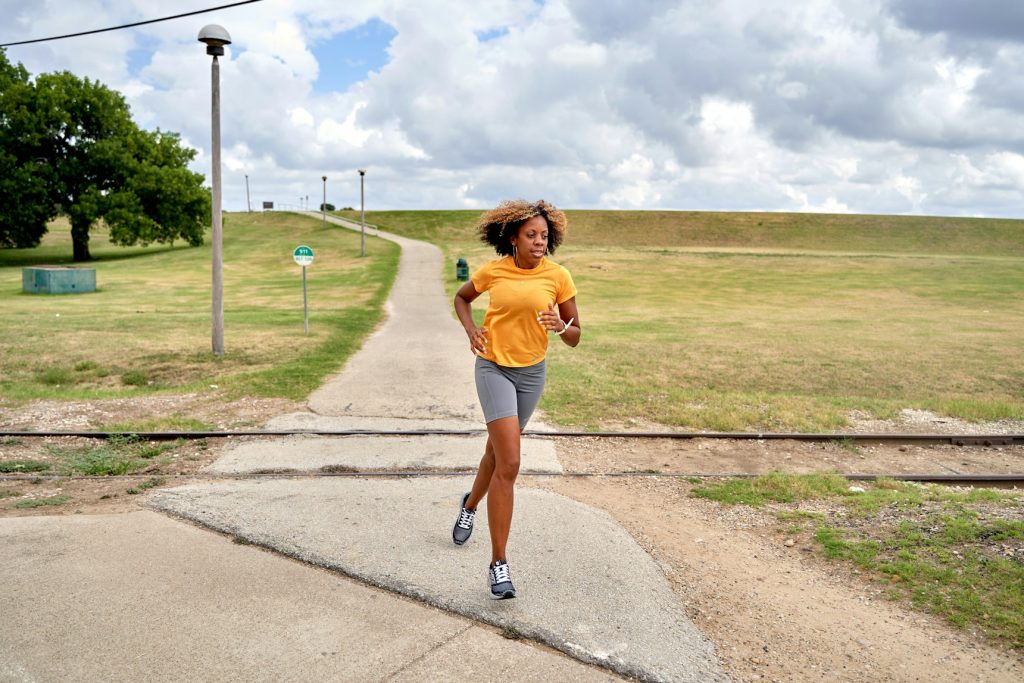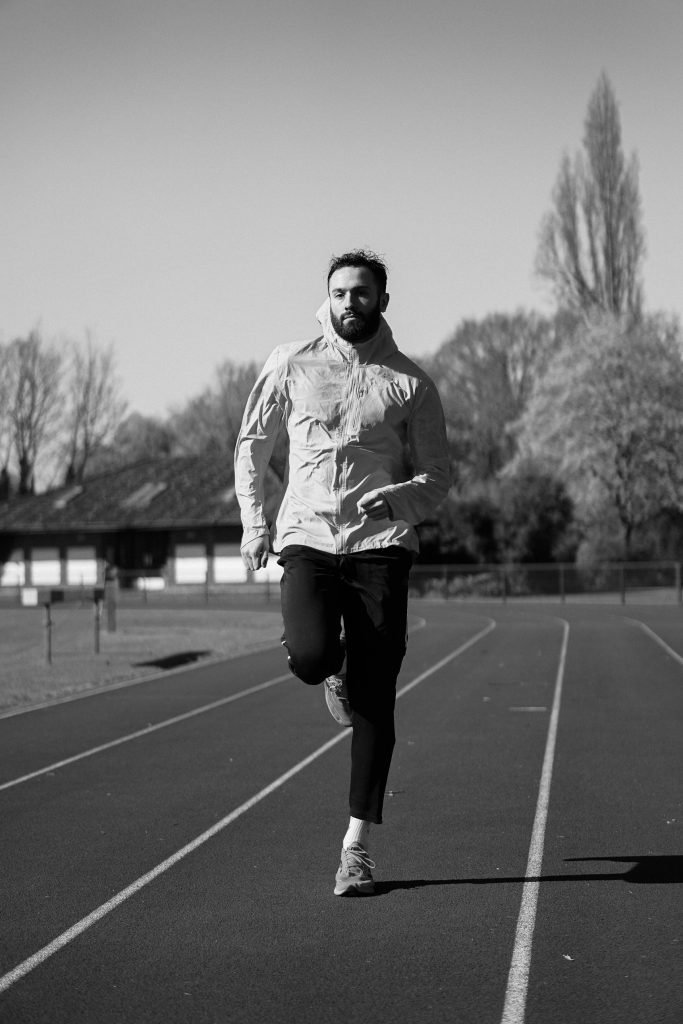Running Injuries
Running is a widely practised form of exercise that offers numerous health benefits. However, it also carries a risk of injury. Common running-related injuries include shin splints, stress fractures, runner’s knee, Achilles tendinitis, plantar fasciitis, and IT band syndrome.
Shin splints present as pain along the shin bone, often resulting from overuse or inappropriate footwear. Stress fractures are minute bone cracks caused by repetitive stress, frequently occurring in runners’ feet and lower legs. Runner’s knee, medically known as patellofemoral pain syndrome, manifests as pain around the kneecap and is typically caused by overuse or muscle imbalances.

Achilles tendinitis is characterized by inflammation of the Achilles tendon, leading to pain and stiffness in the posterior ankle region. Plantar fasciitis, a frequent cause of heel pain, occurs when the plantar fascia—the tissue supporting the foot arch—becomes inflamed. IT band syndrome results in pain on the lateral knee and is often attributed to overuse or improper running technique.
These injuries can significantly impact runners, disrupting training regimens and potentially decreasing overall fitness levels. Recognizing the signs and symptoms of these common running injuries is crucial for seeking appropriate treatment and preventing further damage. By understanding the causes and implementing preventive measures, runners can maintain their health and reduce the likelihood of injury.
Key Takeaways
- Common running injuries include shin splints, runner’s knee, Achilles tendinitis, and plantar fasciitis.
- Causes of running injuries can include overtraining, improper footwear, poor running form, and muscle imbalances.
- Signs and symptoms of running injuries may include pain, swelling, tenderness, and difficulty bearing weight on the affected area.
- Prevention of running injuries involves proper warm-up and cool-down, cross-training, strength training, and wearing appropriate footwear.
- Treatment of running injuries may include rest, ice, compression, elevation, and over-the-counter pain medication.
Causes of Running Injuries
Overuse and Sudden Changes

One of the most common causes of running injuries is overuse. When you run too much or increase your mileage too quickly, you put excessive strain on your muscles, tendons, and bones, leading to inflammation and damage.
Poor Running Mechanics
Poor running mechanics can also contribute to injuries. This includes overstriding, landing with a heavy footstrike, or running with improper form. Additionally, muscle imbalances and weakness in the hips, glutes, and core can lead to compensatory movements that put added stress on certain areas of the body.
External Factors
Other factors that can increase the risk of running injuries include wearing inadequate footwear, such as worn-out shoes or shoes that don’t provide proper support. Running on hard or uneven surfaces, running in extreme weather conditions, and not allowing for adequate rest and recovery between runs can also contribute to injuries. It’s essential for runners to be aware of these potential causes of injury and take steps to address them in order to prevent future problems.
Signs and Symptoms of Running Injuries
Recognizing the signs and symptoms of running injuries is crucial for early intervention and treatment. Common indicators of running injuries include pain, swelling, tenderness, stiffness, and aching in specific areas of the body. For example, shin splints often present as a dull ache along the shin bone during or after running.
Stress fractures may cause localized pain and tenderness in the affected bone, especially with weight-bearing activities. Runner’s knee can cause aching or sharp pain around the kneecap, particularly when going up or down stairs or after prolonged sitting. Achilles tendinitis may result in pain and stiffness in the back of the ankle, especially in the morning or after periods of inactivity.
Plantar fasciitis typically causes stabbing pain in the heel that is most severe with the first steps in the morning or after long periods of standing. It’s important for runners to pay attention to any unusual discomfort or pain and seek medical attention if necessary. Ignoring the signs and symptoms of running injuries can lead to further damage and longer recovery times.
By addressing issues early on, runners can prevent more serious problems from developing.

Prevention of Running Injuries
Preventing running injuries involves a combination of proper training, conditioning, and self-care strategies. Gradually increasing mileage and intensity, cross-training with other activities like swimming or cycling, and incorporating rest days into a training schedule can help reduce the risk of overuse injuries. It’s also important for runners to focus on strength training exercises that target the muscles used in running, such as the hips, glutes, core, and lower legs.
This can help improve overall stability and reduce the risk of muscle imbalances that can lead to injury. Proper footwear is essential for preventing running injuries, so it’s important for runners to wear shoes that provide adequate support, cushioning, and stability. Getting fitted for the right type of shoe based on individual biomechanics and running style can help reduce the risk of foot and lower leg injuries.
Additionally, paying attention to running form and mechanics, such as maintaining a slight forward lean, landing with a midfoot strike, and keeping a quick cadence, can help reduce impact forces on the body. Other preventive measures include warming up before runs with dynamic stretches, cooling down with static stretches after runs, using foam rollers or massage tools to address tight muscles, and listening to the body for signs of fatigue or overtraining. By taking a proactive approach to injury prevention, runners can enjoy their sport while minimizing the risk of injury.
Treatment of Running Injuries
When running injuries occur, it’s important to seek proper treatment in order to facilitate healing and prevent further damage. The RICE (rest, ice, compression, elevation) method is often recommended for acute injuries to reduce pain and inflammation. Resting from running and avoiding activities that exacerbate symptoms is crucial for allowing the body to heal.
Applying ice packs or cold therapy can help reduce swelling and pain in affected areas. Compression bandages or sleeves can provide support and reduce swelling, while elevating the injured area above heart level can help minimize swelling. In addition to the RICE method, over-the-counter pain relievers such as ibuprofen or acetaminophen may be used to manage pain and inflammation.
Physical therapy may also be recommended to address muscle imbalances, improve flexibility, and strengthen weak areas. In some cases, corticosteroid injections or orthotics may be prescribed to alleviate symptoms and support proper alignment. It’s important for runners to follow their healthcare provider’s recommendations for treatment and avoid rushing back into activity before fully recovering from an injury.
By allowing adequate time for healing and following a comprehensive treatment plan, runners can increase their chances of returning to running without further complications.
Rehabilitation and Recovery from Running Injuries

Structured Rehabilitation Programs
Rehabilitation from running injuries involves a gradual return to activity through a structured program designed to rebuild strength, flexibility, and endurance. This may include a combination of physical therapy exercises, cross-training activities like swimming or cycling, and modified running workouts. Rehabilitation programs are tailored to each individual’s specific injury and may focus on improving range of motion, restoring muscle strength, addressing gait abnormalities, and gradually increasing load-bearing activities.
Addressing Underlying Factors
Recovery from running injuries also involves addressing any underlying factors that may have contributed to the injury in the first place. This may include correcting biomechanical issues through gait analysis and orthotic interventions, addressing muscle imbalances through targeted strength training exercises, and modifying training plans to prevent future overuse injuries.
Preventing Re-injury
It’s important for runners to be patient during the rehabilitation process and not rush back into full training too soon. Gradually increasing mileage and intensity while monitoring for any signs of recurring pain or discomfort is essential for preventing re-injury. By following a comprehensive rehabilitation plan and addressing any contributing factors, runners can improve their chances of returning to running at full capacity.
Returning to Running After an Injury

Returning to running after an injury requires careful planning and consideration in order to prevent re-injury and promote long-term health. It’s important for runners to gradually reintroduce running into their routine by starting with short distances at an easy pace and slowly increasing mileage over time. This gradual approach allows the body to adapt to increased stress while minimizing the risk of exacerbating previous injuries.
Incorporating cross-training activities like swimming or cycling can help maintain cardiovascular fitness while reducing impact on injured areas. It’s also important for runners to continue with strength training exercises that target key muscle groups used in running in order to maintain overall stability and reduce the risk of future injuries. Paying attention to any lingering discomfort or pain during runs is crucial for preventing re-injury.
If symptoms persist or worsen, it’s important for runners to seek medical attention in order to address any underlying issues that may be contributing to ongoing problems. By taking a cautious approach to returning to running after an injury and being mindful of any warning signs from the body, runners can increase their chances of resuming their sport without setbacks. It’s important for runners to listen to their bodies throughout this process and not push through pain or discomfort in order to prevent further damage.
In conclusion, running injuries are common among runners but can be managed with proper prevention strategies, early intervention, comprehensive treatment plans, and gradual rehabilitation programs. By understanding the causes and signs of running injuries, as well as how to prevent them through proper training techniques and self-care strategies, runners can minimize their risk of injury while enjoying their sport. It’s important for runners to seek medical attention when needed and follow through with recommended treatment plans in order to facilitate healing and prevent re-injury.
With patience and dedication to rehabilitation programs, runners can return to their sport with confidence while minimizing the risk of future problems.
If you’re interested in learning more about virtual physiotherapy and how it can help with managing running injuries, check out this article on the benefits of virtual physiotherapy. At Physio2Home, we offer virtual physiotherapy services to help you recover from running injuries from the comfort of your own home. Contact us today to learn more about how we can help you get back on track with your running goals. Learn more about our team and our approach to physiotherapy by visiting our about us page.


